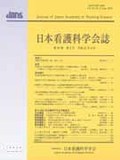Japanese
English
- 販売していません
- Abstract 文献概要
- 参考文献 Reference
- サイト内被引用 Cited by
要旨
【目的】看護系大学共用試験(CBT)用に作成した老年看護学の出題90項目を古典的テスト理論(CTT),および項目反応理論(IRT)を用い正答率,および項目識別度,項目困難度などの特性によりメタ評価した.
【対象と方法】便宜的標本抽出により国公私立看護系23大学の臨地実習前の3年次生730名を対象として,紙筆試験を実施した.分析は正答率,IT双列相関,項目困難度(2PL model),項目識別度,因子負荷量を求め,項目特性曲線等を描いてすべての項目特性を評価した.
【結果】老年看護学の平均正答率は65.8~69.3%で,他科目との相関は薬理学r=0.30~0.41,解剖学・病理学r=0.28~0.38であった(p<0.01).項目困難度(-5.851~4.068),および項目識別度(0.292~2.218)とも幅が広かった.情報量曲線により各項目の特性が示された.90項目中3項目の項目識別度が低かった.
【結論】90項目の問題中87項目はCBTでの利用が可能と考えられた.しかし,このうち71.1%は項目困難度が負の易しい問題であったため,能力水準の高いレベルの受検者の識別に課題が残った.
Abstract
Purpose: We conducted a meta-evaluation of item characteristics such as percentage of correct answers, item discrimination degree and item difficulty using classical test theory(CTT) and item response theory(IRT) for 90 items in a gerontological nursing that created a computer based nationwide common achievement test(CBT) at nursing universities.
Subjects and Methods: We conducted a written monitoring survey by convenience sampling 730 college juniors prior to starting their on-site training at 23 public and private nursing universities. We analysed the percentage of correct answers by CTT, biserial correlations of Item Total(IT), item difficulty by IRT(2PL model), item discrimination degree and factor loading. From these results, we constructed item characteristic curves to evaluate each item's characteristics.
Results: The average percentage of correct answers for gerontological nursing was 65.8-69.3%. The correlation coefficients were r=0.30-0.41 for pharmacology and r=0.28-0.38 for anatomy and pathology(p<0.01).There were large gaps for both item difficulty(-5.851-4.068) and item discrimination degree(0.292-2.218).As a result, the information content curves exhibited each item's characteristics. The item discrimination degrees for 3 out of 90 items were low, which presents a subject for future study.
Conclusion: This study suggests that the remaining 87 items were considered to be usable in CBT however, 71.1% of the items had negative item difficulty, which indicated that they were easy items to answer. There remain some challenges in discriminating highly capable examinees in this CBT items.
Copyright © 2013, Japan Academy of Nursing Science. All rights reserved.


